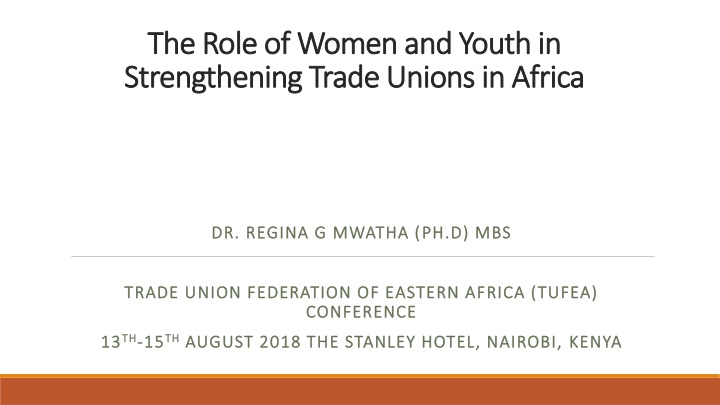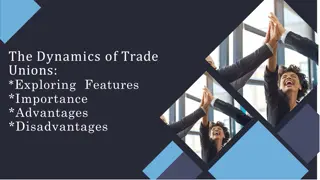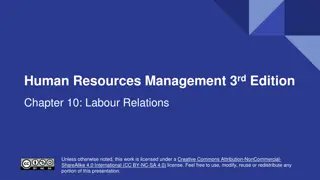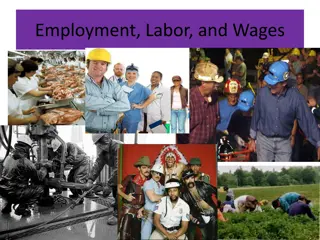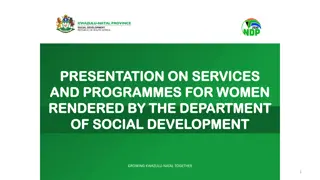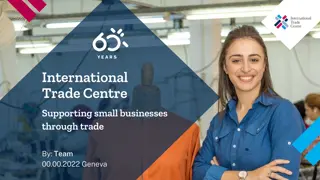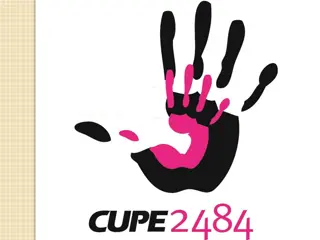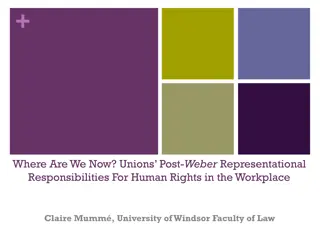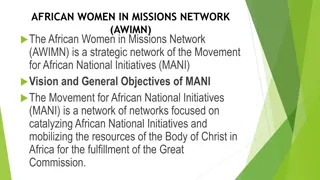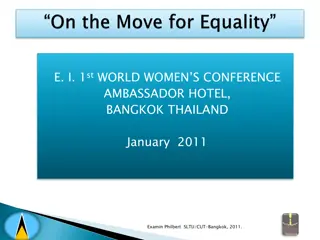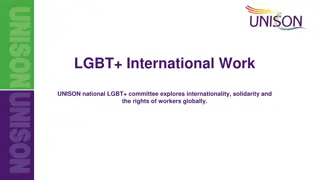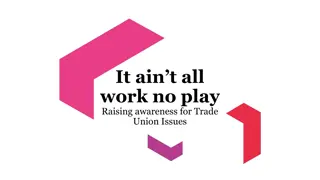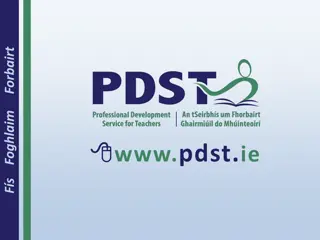Empowering Women and Youth in African Trade Unions
Trade unions play a vital role in addressing labor challenges and promoting decent employment. Gender equality is key, with Africa having examples of female-led unions. Empowering women and youth in union leadership structures is essential for real benefits. Diversifying leadership positions can enhance the impact of unions and better represent workers.
Download Presentation

Please find below an Image/Link to download the presentation.
The content on the website is provided AS IS for your information and personal use only. It may not be sold, licensed, or shared on other websites without obtaining consent from the author.If you encounter any issues during the download, it is possible that the publisher has removed the file from their server.
You are allowed to download the files provided on this website for personal or commercial use, subject to the condition that they are used lawfully. All files are the property of their respective owners.
The content on the website is provided AS IS for your information and personal use only. It may not be sold, licensed, or shared on other websites without obtaining consent from the author.
E N D
Presentation Transcript
The Role of Women and Youth in The Role of Women and Youth in Strengthening Trade Unions in Africa Strengthening Trade Unions in Africa DR. DR. REGINA G MWATHA ( REGINA G MWATHA (PH.D PH.D) MBS ) MBS TRADE TRADE UNION FEDERATION OF EASTERN AFRICA (TUFEA) UNION FEDERATION OF EASTERN AFRICA (TUFEA) CONFERENCE CONFERENCE 13 13TH TH- -15 15TH THAUGUST 2018 THE STANLEY HOTEL, NAIROBI, AUGUST 2018 THE STANLEY HOTEL, NAIROBI, K KENYA ENYA
Outline of the Presentation 1. Introduction 2. within the union leadership structures 3. bring on board other players 4. Different strategy in changing times
Introduction Introduction Trade unions are embedded in one important concern of people s lives their job. They understand the labour challenges in their country and they have practical ideas for overcoming them. They are central advocates for the promotion of decent employment. Gender equality is understood globally as a fundamental human right and as critical for sustainable development and strong participatory democracies. Trade unions understand the importance of gender equality, and Africa boasts strong examples of gender integration policies and majority-female unions. Trade unions make a difference to the lives of women. Trade unions need women and youthful members but can only deliver real benefits if they take seriously the imperative to identify women s and youth concerns and take targeted measures to help/support women and the youth at work and in the trade union democratic structure.
1. Within the Union 1. Within the Union L Leadership eadership S Structures tructures
1.Provision 1.Provision of Diverse Top Union Leadership Positions at National Regional and Top Union Leadership Positions at National Regional and International levels International levels of Diverse Thought Through Increased Participation Thought Through Increased Participation in in Women in trade union leadership are often confined to positions dealing specifically with gender issues rather than serving in the highest-ranking positions, which limits their impact within unions and the capacity of unions to represent workers. Women and their advocates have achieved some concrete gains in terms of increasing women s participation in unions and union leadership BUT Trade unions are likely to benefit more when they diversify their thought and plan process by bringing more women and youth at the at the national regional and international level leadership positions.
Description of Women Unions Officials as placed at branch and National Description of Women Unions Officials as placed at branch and National Level Level in in Kenya 2007 Kenya 2007 Level Frequency Percentage Branch level 14 70.0 National Level 6 30.0 Total 20 100.0
Percent Membership and NEC Gender Representation in Trade Percent Membership and NEC Gender Representation in Trade Unions Unions in Ghana 2014 in Ghana 2014 Members % Female 11.2 30.6 35.0 * 30.0 NEC % Union CBMWU GAWU ICU GMWU GTUC Male 88.8 69.4 65.0 * 70.0 Female 17.2 26.6 21.1 8.3 33.3 Male 82.8 73.4 78.9 91.7 66.7
Link Training and Education to Link Training and Education to Movement P Positions ositions Movement to Higher leadership to Higher leadership Elkiss (1992) conducted a survey in the United States to quantify the move if any into upper level union leadership positions of past participants after they had attended a three-day training program The study showed that only six past participants stated that they had moved into higher leadership positions indicating that the effect of the training was minimal Is the story of the African continent similar to the one in the USA. Training and education must translate in to shifts of upward leadership especially at the trade union level if unions want to see women and youth strengthening the unions.
Mainstreaming Gender: Equality, Equity Mainstreaming Gender: Equality, Equity and Inclusivity and Inclusivity Gender-proof all proposals such as on flexible patterns of working Gender mainstreaming seeks to measure the impact of all policies and actions as they affect women and men and to maximise their positive effect on gender equality. encourage the participation of women, youth and persons with disabilities on committees and collective bargaining units Mainstreaming Gender Equality and equity empowers structures and individual both male and female, youth, those abled differently so that issues of inclusivity in the union can be discussed by any member, any staff with confidence in their programming, budgeting and activities. Train all negotiators in gender equality, equity and inclusivity and include these perspective on all topics
Gender Gender R Responsive Budgeting esponsive Budgeting GRB consists of the use of tools to analyse the gender dimensions of budgets; and adoption of procedures to ensure that the budget supports the achievement of gender equality and equity. It requires better understanding of who are the beneficiaries of the expenditure. GRB is closely related to Gender mainstreaming. Unions should ensure that there is a budget for activities and programmes that benefit women youth and persons with disability. In return these will give back to unions in various programmes in recruitment, retention CBA- In short let the finances go where the Trade Union needs to be strengthened and those whom the union needs to use to strengthen themselves
Encourage Encourage and conferences conferences and proactively proactively provide provide education education and and training training and and By developing a range of strategies to encourage and increase women's and youth involvement, trade unions stand to benefit. These include having national women's and youth and persons with disability (i) committees, (ii) National equality conferences and training and education for these categories (women, youth and persons with disabilities). These measures bring change within the internal life of trade unions, in that women's youth and persons with disability representation, participation and involvement increase over time (Labor research, 2000).
Sex Disaggregated Sex Disaggregated D Data and Actual S Statistics tatistics ata and Actual Collecting clear and up-to-date sex and age disaggregated data to provide statistics that will help influence national policy. Such data will clearly portray the actual statistic of women and youth and the statistic will be a pointer to how they can be involved more in the union strategies that aim at strengthening the trade union depending on their skills. Eg youthful members knowledgeable in ICT can design informative websites, use short messages to communicate to members fast and effectively etc Persons with disability can help in the way not just in how trade union influences laws and policies but how they are structured to meet their needs, including the physical structures like buildings.
Examples Examples Trade unions in Kenya (2017) Number of trade unions in COTU Number of trade unions in TUC Total members in TUC 45 4 *112,176 Female members in TUC Members of trade unions in COTU Female members in COTU Trade union members share of labour force Trade union members to waged workers Female member share of trade unions Male share of Trade Unions Members of affiliated trade unions from the informal economy Number of CBAs (2017) Workers covered by CBAs Share of workers covered by CBA Labour force (2017) Sources: COTU and LO/FTF Council ii Kenya Economic Survey (2017) *41,741 2,481,544 1,215,956 16.2 % 98 % 48 % 52% 1200 298 667,047 4% 15,996,500ii
What is expected from this data 1. Male/ Female member share of trade unions is 52% and 48% respectively but what are the ages? Any persons with disability? 2. Male Female members in COTU- what ages? 3. Members of affiliated trade unions from the informal economy -Provide this by sex and gender and indicate disability again by sex The statistics open eyes of trade unions to begin to extrapolate alongside expected goals and enable them measure milestones. Eg Labour force (2017) of 15,996,500 and a membership of 2,481,544
The push for Data Propels also Professional Women and Men including Youth The push for data will also propel professionals and women come in more easily as professional rather than at the political arena The push for data of this nature brings in the ICT component very strongly
Meeting times Meeting times A primary request from women (youth and persons with disability will also request) for: (a) meetings to be scheduled at more convenient times (b) provide sufficient notice of scheduled meetings (C ) Hold meetings at convenient locations
2. 2. B Bring on Board other ring on Board other Players Players
Inclusion of the Informal Inclusion of the Informal S Sector ector W Workers orkers Two billion of the world s employed population aged 15 and over work informally, representing 61.2 per cent of global employment (ILO). Informality is even higher in in Africa (92.4 per cent) Workers (women, youth and persons with disability ) in the informal sector face myriad problems including harassment, abuse and the confiscation of their goods which lead to instability and insecurity in their income and livelihoods, and loss of property
Inclusion of the Informal Sector Workers Inclusion of the Informal Sector Workers There are cases in which women street vendors have engaged in initiatives and negotiated with the local government and urban planners for a range of improvements, including designated workplaces and the provision of licences and identity cards for street vendors (e.g. in India, South Africa, Papua New Guinea) In India, after 15 years of lobbying by woman workers, a Street Vendors Bill was passed, which allows workers the right to a designated space to earn a livelihood, improve their incomes and create a safe working environment (UN Women, 2015; Bhowmik, 2014) In African countries today the trade unions could be in the fore front of negotiating for these spaces for women and youth and persons with disability. It would then mean that they in turn would be some of the strongest defenders of the trade unions work.
Enhancing a Unions Ability to Organize Enhancing a Unions Ability to Organize U Unorganized Youthful Workers Youthful Workers norganized W Women and omen and It has been argued that having women serve as top officers enhances a union's ability to organize unorganized women workers (Hartmann, 1994; Breger, 1992; Trebilcock, 1991;). Similarly Youth within the trade union structures are likely to attract other youths both men and women Also once women and the youth are in position of influence and power they may use their agency to inject their own beliefs, values and concerns into strategy, policy and actions (Trebilcock, 1991) It is imperative for trade unions to seriously consider radical measures including, setting up advisory committees within their constitutions machinery to ensure that the special interests of it's women and youth members are protected and to ensure women's representation on decision making bodies either through the creation of additional seats or by co-option (Beale, 1982)
Innovatively Including the Excluded ( Innovatively Including the Excluded (U Unemployed, Underemployed or Underpaid ) Underemployed or Underpaid ) nemployed, Majority of Africa's young people are unemployed, underemployed or underpaid and are therefore in the swelling ranks of the working poor. Most employers in African countries in both the private and public sector have resorted to the increasing use of casual, temporary, part- time, contract, sub-contracted and outsourced In Kenya for instance, the proportion of casual workers in the formal sector gradually increased from 17.9 percent in 2000 to 21.2 percent in 2005, 29.7 percent in 2006 and 32.2 percent in 2008
Innovatively Including the Excluded Innovatively Including the Excluded (Unemployed, Underemployed or Underpaid ) (Unemployed, Underemployed or Underpaid ) Trade unions must find ways of ensuring that these youth are included even as they fall in to and out of work. That their voices are heard and their spaces at the work place are negotiated for by the trade unions. By listening to them, their world view as workers will also be documented and unions will find strategies of negotiating for their space. Young people s participation is about sharing ideas, thinking for themselves, expressing their views effectively, planning, prioritizing and being involved in the decision making processes.
Innovatively including the excluded (Persons with Innovatively including the excluded (Persons with disability; or differently abled) disability; or differently abled) Many African countries have revised their constitutions, Kenya 2010; Zimbabwe, Ghana just to mention a few. The new laws have clauses that catapult on board of the working persons with disability with created quotas. Unions must embrace on strategies to bring on board these workers voices and thoughts in a manner that influences policy. Persons with disability have workplace needs that unions will find themselves negotiating for in a manner that gives trade unions a lot of strength while empowering their workers.
3. Different Strategies in 3. Different Strategies in Changing Times Changing Times
Disparities Between Law and Adherence to Disparities Between Law and Adherence to Implementation Implementation African countries have a significant body of laws relevant to worker rights and have ratified many of the relevant international conventions However, while official government policies and laws may be praiseworthy, implementation often lags far behind Women are great negotiators and if placed in positions of leadership could play a major role in the negotiation process for implementation of the same
Participating in other Matters of National Participating in other Matters of National I Importance mportance Constitutionalism and constitution making processes including implementation. Examples of COTU (K). Following the political skirmishes that followed the 2007 general elections, COTU (K) was the first organization to warn the government that Kenyans wanted a new constitution. The 2010 Constitution has several rights for women, youth, children persons with disability, including rights of workers.
Strengthening Partnerships to Strengthening Partnerships to A Advocate for Workers Rights at the National Regional and International level Rights at the National Regional and International level dvocate for Workers Trade unions must strengthen their partnerships with relevant institutions that support women, youth and persons with disability rights. Many African countries now have the office of the Ombudsman- Many workers take their grievances there. Some of the issues could be sorted at the trade union level for their member so partnering with the offices of the Ombudsman could strengthen the voice of the union.
Strengthening Strengthening Partnerships Rights Rights at at the the National National Regional Using a common platform to push the agenda, strong partnerships with Regional bodies such as EAC, SADC, AU etc. Needs of women and youth workers across the continent abit different, these groups can best explain them to the union for further negotiation by the unions. Partnerships to to Advocate Regional and Advocate for and International International level for Workers Workers level At the international level need to participate in the Commission on the Status of Women (CSW) and be more visible at ILO which is already a friend to trade unions
Enhance Use of ICT to Reach out to Enhance Use of ICT to Reach out to T The Youth Youth he Young people are the main users of the new ICTs (internet, mobile phone, and computer) which are growing much faster than older ICTs (television, radio, mainline telephones, and newspapers). Youth, both men and women are heavy consumers of ICT. If they have to be useful to the Trade unions, the trade unions like political parties, must identify how ICT will be used to capture the youth since the new ICT technologies are having wide-ranging effects on youth transitions.
Decent Work: Right Partnerships to Speak Decent Work: Right Partnerships to Speak out for Migrant Workers out for Migrant Workers In most African countries migrant workers are not a new phenomenon. Statistics are not available but largely these tend to be young, both men and women Recently in Kenya, the Kenya Union of Domestic, Hotel, Educational Institutions, Hospitals, and Allied Workers (KUDHEIHA), a Solidarity Center partner, made key progress in its struggle to strengthen the rights of workers who migrate from the country for work. In East Africa workers have migrated to Saudi Arabia Labor brokers often give workers false information about the wages and working conditions in other countries. The Solidarity Center has partnered with national trade unions to empower workers to raise their voice for dignity on the job, justice in their communities and greater equality in the global economy .
Decent Work: Right Partnerships to Speak Decent Work: Right Partnerships to Speak out for Migrant Workers out for Migrant Workers Migrant workers in turn have a potential to strengthen trade unions when they speak to colleagues on likely support by joining a trade union. A new proposal, crafted by Kenya s Labor Ministry and KUDHEIHA, would require employers workers with their contracts up front, so that there is no question of what workers should expect before they leave to provide
Creating a Vested Creating a Vested I Interest in Terror Terror nterest in C Combating ombating In East Africa terrorism decimates among other economies the tourist industry which is a major income earner to many trade union members. Tourism being a hospitality industry is mainly a service industry, therefore Housekeeping & laundry department, Food and beverage and kitchen department form the largest departments. This is because business focus is on the sale of beds, food and catering services Young women and men are therefore a huge percentage in these industries Trade union voices condemning terrorist activities could attract young men and women as well as informal sector business owners in to trade union enrolment and work
